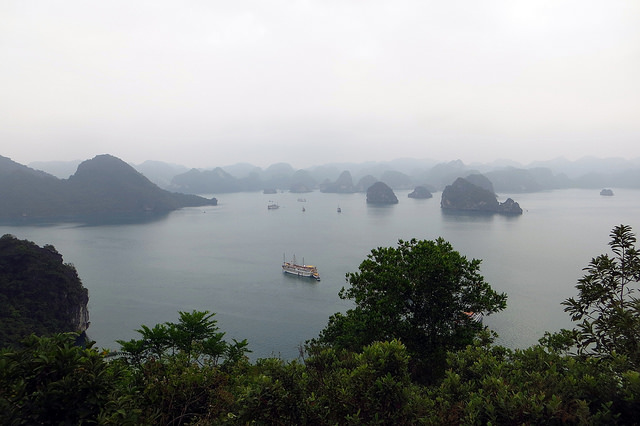President Xi Jinping’s visit to Vietnam on November 5-6 was the first by a Chinese president in 10 years. Hu Jintao made a trip in November 2005, when relations between the two countries were relatively relaxed. The period from 2006 to 2008, when China reached out to Southeast Asian neighbors and cooperated with the United States on a number of important issues, was one of the most constructive in the modern history of Chinese foreign policy.
But in recent years, many countries in the region have come to see China as more assertive following incidents like its occupation of Scarborough Shoal in 2012 and its vast reclamation projects on seven features in the Spratly Islands. The China-Vietnam relationship hit a record low in May 2014 following the deployment of a Chinese oil drilling platform in Vietnam’s claimed exclusive economic zone, and has yet to return its previous level. Ahead of Xi’s visit, an open letter began circulating online on October 15 signed by more than two hundred vocal Vietnamese bloggers and activists, including intellectuals and former high-ranking bureaucrats, denouncing China’s aggressive behavior in the South China Sea and asking the Vietnamese government to take a tough stance in settling territorial disputes.
Despite speculation, the South China Sea dispute was not the focus of Xi’s visit. The dispute was dealt with very parsimoniously during his talks with Communist Party General Secretary Nguyen Phu Trong, President Truong Tan Sang, Prime Minister Nguyen Tan Dung, and National Assembly Chairman Nguyen Sinh Hung, as well as in his speech to a session of the National Assembly.
President Xi and Prime Minister Dung agreed to manage tensions through consultation, and to maintain maritime stability based on a 2011 bilateral Agreement on Basic Principles Guiding the Settlement of Sea-Related Issues. General Secretary Trong stressed to Xi the importance of maintaining the status quo, refraining from expanding the scope of the dispute, and avoiding militarization of islands. The Chinese president, through a sugarcoated speech and promises about renewed aid, offered Vietnam more carrots than sticks.
Xi’s visit had a straightforward purpose: he wanted to reassure Vietnamese leaders that China’s intentions in the South China Sea are benign. Why did he choose to show such restraint during the visit to Hanoi?
The United States, after struggling domestically to reach consensus on how best to respond to China’s assertive behavior, appears to have adopted a tougher policy. The recent transit of a U.S. Navy destroyer within 12 nautical miles of a Chinese artificial islands in the Spratlys received plaudits from Australia, Japan, and the Philippines, and implicit endorsements from other countries like Vietnam. China is responding by making overtures toward regional countries inclined to lean toward the United States, including Vietnam. At the same time, China is hinting that great power rivalry between China and the United States could inflict heavy damage on smaller states.
Amid this tense situation, China’s latest charm offensive in Vietnam has been mired in controversy over economic sovereignty and political priorities. The complexity of the Vietnam-China relationship has multiplied given the widening power gap between the two countries. Like other Southeast Asian nations, Vietnam is witnessing the global power shift in favor of China but Vietnamese leaders assume that they know how to manage their relationship with great powers to serve their national interests. Some might have an overly sanguine belief that Xi’s visit indicates China has shifted to an inclusive and cooperative approach to resolve the disputes in the South China Sea. But Vietnamese history buffs will find it hard to trust any such Chinese offers. So yes, Xi’s visit was a big deal, and perhaps even historic, but it was also more symbolic than substantive.
The decision to host a high-profile visit by President Xi at all was a risk by the Vietnamese leadership. With only three months until the Vietnamese Communist Party’s next congress, open advocacy of a more accommodating policy toward China could prove politically dangerous amid the fierce contest for key positions in Vietnam’s political system. The price could prove costly if Xi’s visit leads to further outbursts of anti-China nationalism or causes speculation that Beijing is trying to impact Vietnam’s leadership transition.
Consequently, the leadership in Hanoi was pragmatic. Immediately after Xi’s visit, Vietnamese officials hosted Japan’s defense minister Gen Nakatani for a two-day visit that focused heavily on maritime security in the South China Sea. During the trip, Nakatani announced that Vietnam had invited Japan to take part in humanitarian exercises and to have a Maritime Self Defense Forces ship visit the strategic naval base at Cam Ranh Bay. Earlier this year, Japan delivered the first of six patrol vessels promised to the Vietnam Marine Police. The remaining ships will be delivered later this year and will be valuable additions to Hanoi’s inadequate maritime security capabilities.
